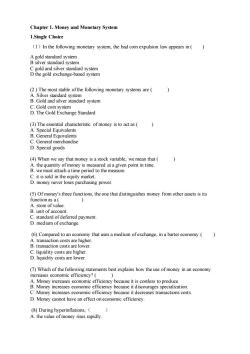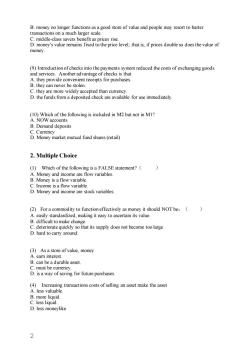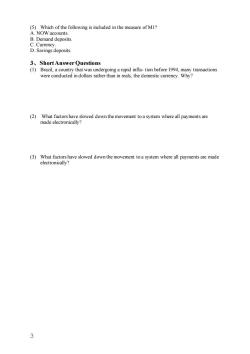同济大学:《货币金融学》课程教学资源(试卷习题)Chapter 1 Money and Monetary System

Chapter 1.Money and Monetary System 1.Single Choice (1)In the following monetary system,the bad coin expulsion law appears in ( A gold standard system B silver standard system C gold and silver standard system D the gold exchange-based system (2)The most stable of the following monetary systems are A.Silver standard system B.Gold and silver standard system C.Gold coin system D.The Gold Exchange Standard (3)The essential characteristic of money is to act as A.Special Equivalents B.General Equivalents C.General merchandise D.Special goods (4)When we say that money is a stock variable,we mean that A.the quantity of money is measured at a given point in time. B.we must attach a time period to the measure. C.it is sold in the equity market. D.money never loses purchasing power. (5)Of money's three functions,the one that distinguishes money from other assets is its function as a( A.store of value. B.unit of account C.standard of deferred payment. D.medium of exchange (6)Compared to an economy that uses a medium of exchange,in a barter economy ( A.transaction costs are higher. B.transaction costs are lower. C.liquidity costs are higher. D.liquidity costs are lower. (7)Which of the following statements best explains how the use of money in an economy increases economic efficiency?() A.Money increases economic efficiency because it is costless to produce. B.Money increases economic efficiency because it discourages specialization. C.Money increases economic efficiency because it decreases transactions costs. D.Money cannot have an effect on economic efficiency. (8)During hyperinflations, A.the value of money rises rapidly
Chapter 1. Money and Monetary System 1.Single Choice (1)In the following monetary system, the bad coin expulsion law appears in ( ) A gold standard system B silver standard system C gold and silver standard system D the gold exchange-based system (2 ) The most stable of the following monetary systems are ( ) A. Silver standard system B. Gold and silver standard system C. Gold coin system D. The Gold Exchange Standard (3) The essential characteristic of money is to act as ( ) A. Special Equivalents B. General Equivalents C. General merchandise D. Special goods (4) When we say that money is a stock variable, we mean that ( ) A. the quantity of money is measured at a given point in time. B. we must attach a time period to the measure. C. it is sold in the equity market. D. money never loses purchasing power. (5) Of money's three functions, the one that distinguishes money from other assets is its function as a ( ) A. store of value. B. unit of account. C. standard of deferred payment. D. medium of exchange. (6) Compared to an economy that uses a medium of exchange, in a barter economy ( ) A. transaction costs are higher. B. transaction costs are lower. C. liquidity costs are higher. D. liquidity costs are lower. (7) Which of the following statements best explains how the use of money in an economy increases economic efficiency? ( ) A. Money increases economic efficiency because it is costless to produce. B. Money increases economic efficiency because it discourages specialization. C. Money increases economic efficiency because it decreases transactions costs. D. Money cannot have an effect on economic efficiency. (8) During hyperinflations,( ) A. the value of money rises rapidly

B.money no longer functions as a good store of value and people may resort to barter transactions on a much larger scale. C.middle-class savers benefit as prices rise. D.money's value remains fixed to the price level;that is,if prices double so does the value of money. (9)Introduction of checks into the payments system reduced the costs of exchanging goods and services.Another advantage of checks is that A.they provide convenient receipts for purchases. B.they can never be stolen. C.they are more widely accepted than currency. D.the funds from a deposited check are available for use immediately. (10)Which of the following is included in M2 but not in M1? A.NOW accounts B.Demand deposits C.Currency D.Money market mutual fund shares(retail) 2.Multiple Choice (1)Which of the following is a FALSE statement?( ) A.Money and income are flow variables. B.Money is a flow variable. C.Income is a flow variable. D.Money and income are stock variables. (2)For a commodity to function effectively as money it should NOT be:( A.easily standard ized,making it easy to ascertain its value. B.difficult to make change. C.deteriorate quickly so that its supply does not become too large. D.hard to carry around. (3)As a store of value,money A.earn interest. B.can be a durable asset. C.must be currency. D.is a way of saving for future purchases (4)Increasing transactions costs of selling an asset make the asset A.less valuable B.more liquid. C.less liquid. D.less moneylike 2
2 B. money no longer functions as a good store of value and people may resort to barter transactions on a much larger scale. C. middle-class savers benefit as prices rise. D. money's value remains fixed to the price level; that is, if prices double so does the value of money. (9) Introduction of checks into the payments system reduced the costs of exchanging goods and services. Another advantage of checks is that A. they provide convenient receipts for purchases. B. they can never be stolen. C. they are more widely accepted than currency. D. the funds from a deposited check are available for use immediately. (10) Which of the following is included in M2 but not in M1? A. NOW accounts B. Demand deposits C. Currency D. Money market mutual fund shares (retail) 2. Multiple Choice (1) Which of the following is a FALSE statement?( ) A. Money and income are flow variables. B. Money is a flow variable. C. Income is a flow variable. D. Money and income are stock variables. (2) For a commodity to function effectively as money it should NOT be:( ) A. easily standardized, making it easy to ascertain its value. B. difficult to make change. C. deteriorate quickly so that its supply does not become too large. D. hard to carry around. (3) As a store of value, money A. earn interest. B. can be a durable asset. C. must be currency. D. is a way of saving for future purchases. (4) Increasing transactions costs of selling an asset make the asset A. less valuable. B. more liquid. C. less liquid. D. less moneylike

(5)Which of the following is included in the measure of M1? A.NOW accounts. B.Demand deposits. C.Currency. D.Savings deposits. 3,Short Answer Questions (1)Brazil,a country that was undergoing a rapid infla-tion before 1994,many transactions were conducted in dollars rather than in reals,the domestic currency.Why? (2)What factors have slowed down the movement to a system where all payments are made electronically? (3)What factors have slowed down the movement to a system where all payments are made electronically? 3
3 (5) Which of the following is included in the measure of M1? A. NOW accounts. B. Demand deposits. C. Currency. D. Savings deposits. 3、Short Answer Questions (1) Brazil, a country that was undergoing a rapid infla- tion before 1994, many transactions were conducted in dollars rather than in reals, the domestic currency. Why? (2) What factors have slowed down the movement to a system where all payments are made electronically? (3) What factors have slowed down the movement to a system where all payments are made electronically?
按次数下载不扣除下载券;
注册用户24小时内重复下载只扣除一次;
顺序:VIP每日次数-->可用次数-->下载券;
- 同济大学:《货币金融学》课程教学资源(大纲教案)教学大纲 The Economics of Money and Banking.pdf
- 吉林大学:《财政学》课程教学资源(试卷习题)远程教育考试样卷(无答案).doc
- 吉林大学:《经济法》课程电子教案(PPT教学课件,共十三章,授课对象:远程教育,授课教师:孙凤英).ppt
- 《财务管理》课程教学资源(专项报告)南宁市宾阳县生猪现代农业产业园实施方案(简版).pdf
- 《财务管理》课程教学资源(专项报告)存栏1120头商品猪养殖小区可行性研究报告(简版).pdf
- 《财务管理》课程教学资源(专项报告)存栏2000头祖代原种猪场可行性研究报告(简版).pdf
- 《财务管理》课程教学资源(专项报告)存栏3000头曾祖代原种猪场环保生态养殖综合开发项目可研报告(简版).pdf
- 《财务管理》课程教学资源(专项报告)存栏5000头基础母猪现代化生猪养殖场可行性研究报告(简版).pdf
- 《财务管理》课程教学资源(专项报告)山西灵空山国家级自然保护区2016年林业国家级自然保护区补助资金建设项目可行性研究报告(简版).pdf
- 《财务管理》课程教学资源(专项报告)森林康养度假建设项目可行性研究报告(简版).pdf
- 山西农业大学:《财务管理》课程教学资源(试卷习题)财务管理期末考试模拟题三及答案.pdf
- 山西农业大学:《财务管理》课程教学资源(试卷习题)财务管理期末考试模拟题二及答案.pdf
- 山西农业大学:《财务管理》课程教学资源(试卷习题)财务管理期末考试模拟题一及答案.pdf
- 山西农业大学:《财务管理》课程教学资源(试卷习题)第八章 利润分配管理(含答案).pdf
- 山西农业大学:《财务管理》课程教学资源(试卷习题)第七章 营运资金管理(含答案).pdf
- 山西农业大学:《财务管理》课程教学资源(试卷习题)第五章 固定资产投资(含答案).pdf
- 山西农业大学:《财务管理》课程教学资源(试卷习题)第四章 筹资(含答案).pdf
- 山西农业大学:《财务管理》课程教学资源(试卷习题)第九章 财务报表分析(含答案).pdf
- 山西农业大学:《财务管理》课程教学资源(试卷习题)第二章 资金时间价值(含答案).pdf
- 山西农业大学:《财务管理》课程教学资源(试卷习题)第一章 财务管理总论(含答案).pdf
- 同济大学:《货币金融学》课程教学资源(试卷习题)Chapter 2 Credit and Financial Instruments.docx
- 同济大学:《货币金融学》课程教学资源(试卷习题)Chapter 3 Interest and Interest Rate.docx
- 同济大学:《货币金融学》课程教学资源(试卷习题)Chapter 4 The Economics of Financial Intermediary.docx
- 同济大学:《货币金融学》课程教学资源(试卷习题)Chapter 5 Commercial Banks.docx
- 同济大学:《货币金融学》课程教学资源(试卷习题)Chapter 6 Central Banks.docx
- 同济大学:《货币金融学》课程教学资源(试卷习题)Chapter 7 Financial Markets.docx
- 同济大学:《货币金融学》课程教学资源(试卷习题)Chapter 8 Money Supply and Money Demand.docx
- 同济大学:《货币金融学》课程教学资源(试卷习题)Chapter 9 Money and Inflation.docx
- 同济大学:《货币金融学》课程教学资源(试卷习题)Answers for Test Sample(参考答案)Chapter 1-10.docx
- 同济大学:《货币金融学》课程电子教案(课件讲稿)Chapter 1 Introduction(负责人:郭英).pdf
- 同济大学:《货币金融学》课程电子教案(课件讲稿)Chapter 2 Money and Monetary System.pdf
- 同济大学:《货币金融学》课程电子教案(课件讲稿)Chapter 3 Credit and Financial Instrument.pdf
- 同济大学:《货币金融学》课程电子教案(课件讲稿)Chapter 4 Interest and Interest Rate.pdf
- 同济大学:《货币金融学》课程电子教案(课件讲稿)Chapter 5 Financial Institutions.pdf
- 同济大学:《货币金融学》课程电子教案(课件讲稿)Chapter 6 Commercial Banks.pdf
- 同济大学:《货币金融学》课程电子教案(课件讲稿)Chapter 7 Central Banks.pdf
- 同济大学:《货币金融学》课程电子教案(课件讲稿)Chapter 8 Financial Markets.pdf
- 同济大学:《货币金融学》课程电子教案(课件讲稿)Chapter 10 Monetary Policy.pdf
- 同济大学:《货币金融学》课程电子教案(课件讲稿)Chapter 9 Money Demand and Money Supply.pdf
- 同济大学:《货币金融学》课程电子教案(课件讲稿)Chapter 11 Inflation and Deflation.pdf
